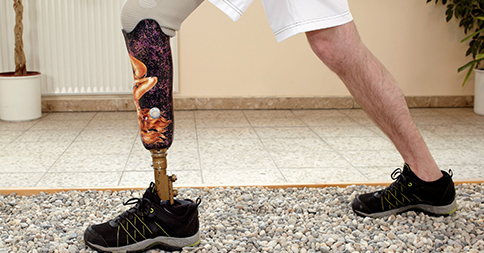If you’ve recovered from your lower-extremity limb loss to the point that you’re moving pretty well and you have a decent range of motion, you may be ready to try some exercises that will help you build strength. As always, before you start any kind of exercise program, you should talk with your doctor and your prosthetist to determine whether you are ready for something like this. You don’t want to rush it – but if your body is ready, it can be a great way to start feeling more normal!
Read on to learn about some exercises you can do after lower-extremity limb loss.
Seated Push-Up
Put a sturdy chair against a wall so that it won’t tip over. Sit in the chair and place your hands on the armrests. Push down onto the armrests, raise your hips a couple of inches off of the seat, and then bring yourself back down. For more of a challenge, lift one leg during the exercise.
Partial Squats
While holding on to something sturdy, distribute your weight evenly onto both legs, and squat as if you were sitting on a tall stool. Don’t try to do a full squat – just a partial one. Repeat 10 times. Strengthening the thigh muscles will make it easier to sit and rise from a chair.
Pelvic Tilt
Lying on your back, with or without your prosthesis, bend your hips and knees to a 90 degree angle. Place your hands just above your knees, and press down with your stomach muscles to flatten the small of your back. Keep your thighs still. Hold steady for two to three seconds, breathing normally. This move strengthens the abdominal muscles (stomach). For more of a challenge, lift your head.
Even Weight Bearing
Think about how much weight you have on each leg. Many people with limb loss put all of their weight onto the unaffected leg, using the prosthesis as a crutch. Make an effort to stand with your weight evenly on both legs while you perform one daily task, such as talking on the phone or making coffee. By being aware and changing this one habit, you can make improvements in your balance on a daily basis.
Braiding
Using a sturdy piece of furniture for balance assistance, take a few steps to one side, crossing your prosthetic leg in front of, and then behind, your unaffected leg. Stand up as straight as possible and use your hands only for balance, if you can. If your amputation is above the knee, stick with small steps so that you don’t put too much weight on the toe of your prosthesis. This could cause the knee to bend.
BioTech Is Here for You!
Whether you need help with a fitting or advice for after-amputation care, BioTech is here to help. Contact us today for all your prosthetic needs!
